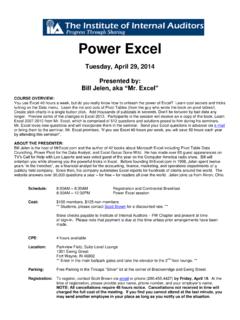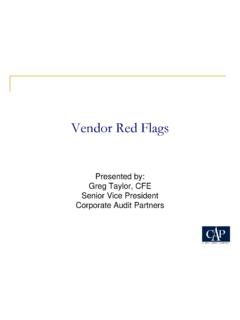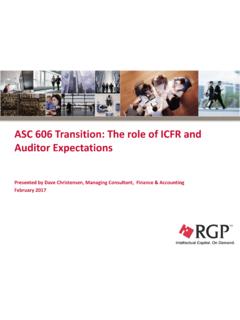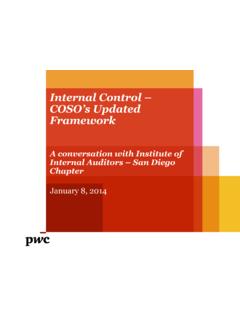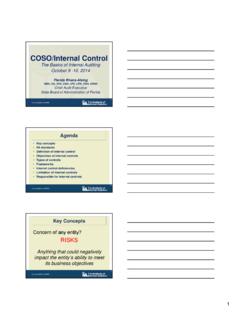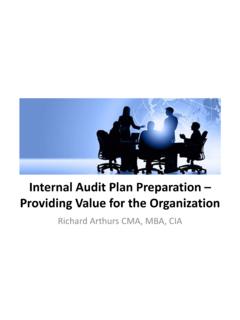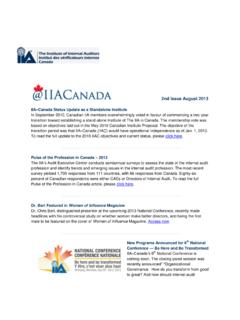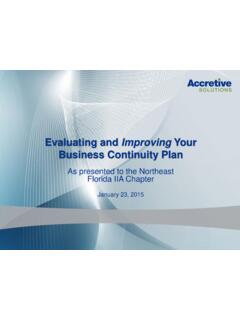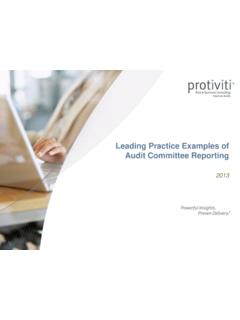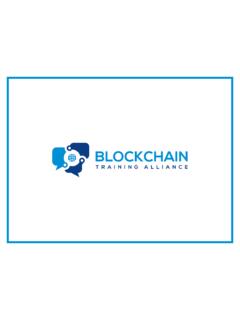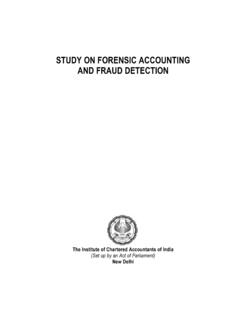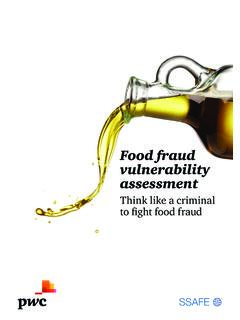Transcription of Data Analytics for Internal Auditors Getting Started and ...
1 Data Analytics for Internal Auditors Getting Started and Beyond A Presentation for Auditors 2 Presenter Christopher Mishler, CMA, CIA, CISA SME User-Developed Application Risks Experis Finance 3 Experis Finance Experis Finance is the risk advisory, tax and finance & accounting organization within the $ billion professional services firm Experis Experis is the premier professional services organization within ManpowerGroup, a $21 billion global workforce solutions organization National directors oversee each dedicated practice area Risk Advisory, Tax and Finance & Accounting and associated Centers of Expertise Risk Advisory Tax Finance & Accounting Internal Audit, Controls, and Regulatory Compliance Governance and Risk Management Information Technology Federal Tax Compliance and Consulting Tax Accounting Reporting and Consulting Tax Risk Management Financial Reporting and Compliance Process Optimization Finance Organization Support 4 Internal Audit.
2 Controls and Regulatory Compliance Governance and Risk Management Information Technology Business System Services Center of Expertise Construction Services Center of Expertise Information Security Center of Expertise Contract Compliance and Cost Recovery Internal Audit Strategic Sourcing Financial Institution Internal Audit Internal Control Optimization Quality Assessment Review Sarbanes-Oxley Compliance Financial Institution Regulatory Compliance and Internal Audit Enterprise Risk Assessment and Management fraud Risk Assessment Technology Risk Assessment Business Continuity Management Disaster Recovery Information Technology Audit Information Technology Governance Business Case Development and Software Selection System Rationalization Systems Management and Risk Management ERP Solution Delivery System Controls and Security Enterprise Data Management, Technology Governance.
3 And Business Analytics Construction Audit Construction Financial Management and Optimization Information Security Governance Privacy and Regulatory Compliance Cyber Security PCI/DSS Experis Risk Advisory Practice 5 Today s Objectives Introduction to Data Analytics Why It s Important to Internal Auditors Overview of the Key Elements, Attributes, Challenges Steps in the Data Analytics Process Data Analytic Tools Roles and Responsibilities Applications for Internal Audit Resources 6 A definition The process of inspecting, cleansing, transforming and modeling data with the objective of highlighting meaningful information, suggesting conclusions, and supporting decision-making.
4 There are two kinds of people. Those who can extrapolate conclusions from incomplete data. What is Data Analytics ? 7 What is Data Analytics ? MORE! Problem-solving process Extracts insights Historical, real-time, or predictive Data Analytics (DA) can be: Risk-focused: , controls effectiveness, fraud , waste, policy/regulatory non-compliance or Performance-focused: , increased sales, decreased costs, improved profitability. 8 What is Data Analytics ? FOCUS on Relationships Identify and interpret relationships among variables to facilitate decision-making using the 5 W s: Who What Why Where When 9 Why is Data Analytics Important to Internal Audit?
5 Strategic Area Enhancement Company Expectations Audit coverage, quality, business impact, on a finite audit budget Regulatory Expectations Stronger assurance and quantifiable results Competitive Landscape Strengthen capabilities Seek new talent Increased Value Deeper discussion on issues (Higher cost recovery?) Develop/strengthen relationships Talent Development Strengthen business skills Appeal to other staff members Boost recruiting Business Partnership Transition skills and methods to the rest of the business 10 Internal audit departments leverage data Analytics in order to: Identify additional Better understand existing risks Provide more assurance coverage Provide insights to management Why is Data Analytics Important to Internal Audit?
6 11 Why is Data Analytics Important to Internal Audit? Some areas that benefit from data Analytics : Sales & Operations Finance & Accounting Order to Cash, Procure-to-Pay Legal & Regulatory Compliance IT infrastructure 12 Important to the Business Important to IA Source: , Downloaded 12/8/15. Challenges to using Data Analytics 14 People Limited resources (financial and human) to execute on a sustained basis Appetite for investment in time and training needed to develop an effective DA process Someone needs to create, run, and maintain the queries Proficiency using analytic software Proficiency in performing analysis The top barrier for implementation of big data Analytics is inadequate staffing or skills for big data Analytics .
7 (Source: The Data Warehousing Institute (TDWI)) Challenges to using Data Analytics 15 Challenges to using Data Analytics Senior Analysts 16 Challenges to using Data Analytics Process Process Area Components for Success Objectives Determine them Establish consensus Strategy and Governance 1)Change Management 2)Validation 3)Access 4)Data Security 5)Documentation 6)Maintenance Measuring Success Cost-benefit ratio or KRI/KPIs Asset recovery Reduced fines Increased labor efficiency Pilot First Deliberately small Low-hanging fruit (T & E?) Easily automated Refine the process 17 Technology Tool selection Available support Initial and ongoing costs $$ Integrating with systems Data considerations Training Challenges to using Data Analytics 18 Data Availability Accessibility Quality Format Centralized Storage Security Privacy Challenges to using Data Analytics Data Analytic Process Steps 20 BADIR Framework PROCESS STEP DESCRIPTION Business Questions Understand what s really going on.
8 Ask the right, relevant questions about the business process. ( 6 questions ) Analytical Plan Goals, Hypotheses, Method/Data Spec, Project Plan Data Collection Pull, cleanse, validate (GIGO!) Insights Review patterns, prove/disprove hypotheses, present findings in quantified impacts for easy priorities Recommendations Based on key insights, supported by detailed findings. Actionable! One Story Key Message *Adapted from Behind Every Good Decision by Piyanka Jain & Puneet Sharma 21 SOX Approach Year 2 and Beyond OR, A four-phased approach for deploying Data Analytics .
9 Phase 1 Scope & Plan Phase 2 Obtain & Validate Data Phase 3 Perform Analysis Phase 4 Interpret & Report Results A Data Analytics Approach 22 Phase 1 Scope & Plan Objective Define the objective(s) or business questions and plan to conduct the analytic. Key Activities Identify the audit objective(s) of the analytic Determine the approach to achieve the audit objective of the analytic Identify the data elements required to execute the approach Discuss the approach with data owners, IT Department and key stakeholders Identify Systems, Data Storage, Data Owners, Data Format (specs) and File Requirements Plan, prioritize and document the tests (in plain language)
10 Deliverables Analytic Requirements Document List of data sources and expected outputs Resource plan, timelines and estimated effort 23 Phase 2 Obtain & Validate Data Objective Obtain the data necessary to achieve the analytic objectives. Key Activities Develop Request for Required Data Determine Method(s) and facilitate delivery and storage of Data Verify Completeness and Accuracy of Data (validate) Identify any Gaps in Required Data (cleanse if needed) Deliverables Formalized data request Verification of receipt and functionality of required data sets Established data and script repositories List of identified gaps in data 24 Phase 3 Perform Analysis Objective using standard tools, perform analysis consistent with analytic objectives.
